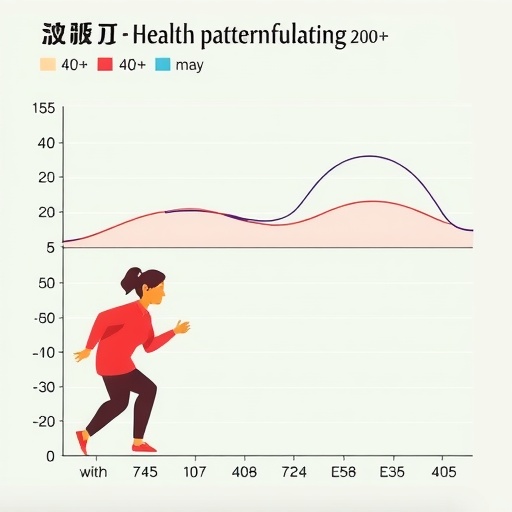In a groundbreaking new study that challenges conventional wisdom around metabolism and obesity, researchers have unveiled intricate links between basal metabolic rate (BMR) and body temperature regulation in mammals. This pioneering work, published in International Journal of Obesity, delves deeply into how variations within species in BMR affect body temperature and its stability, particularly in laboratory rodents with differing propensities for obesity. The findings carry profound implications for understanding the physiological underpinnings of obesity risk and metabolic disorders, fostering novel perspectives on metabolic health.
Basal metabolic rate, the measure of the minimum energy expenditure to sustain life at rest, has long been recognized as a cornerstone in metabolic physiology. However, its evolutionary coupling with body temperature—another critical determinant of energy balance—has not been sufficiently elucidated at the intraspecific level. This study takes a pioneering approach by focusing on the variability within a species, specifically laboratory mice selected for divergent BMR values, to unravel how these metabolic parameters interact and collectively influence susceptibility to obesity.
Central to the research is the observation that both low BMR and reduced body temperature are often co-expressed traits that enhance the risk of obesity. These physiological states may contribute to decreased energy expenditure and altered thermogenic processes, setting the stage for increased fat deposition. Additionally, the lability of body temperature, or its propensity to fluctuate in response to external stressors such as food scarcity or cold environments, was identified as a crucial factor. High instability in body temperature regulation emerged as a marker of vulnerability to metabolic dysfunction.
The researchers utilized laboratory mice that had undergone selective breeding to either amplify or suppress basal metabolic rate, generating distinct groups exhibiting high and low BMR phenotypes. These groups were further stratified by their predisposition towards obesity—key to dissecting how metabolic rates interact with adiposity levels. Through meticulous longitudinal measurements of body temperature and energy metabolism across these cohorts, the team revealed nuanced patterns that redefine existing paradigms.
Mice with inherently low BMR not only exhibited lower core body temperatures but also demonstrated greater thermoregulatory lability. Their body temperatures were significantly more sensitive to impositions of unfavorable conditions, indicating impaired physiological stability. Conversely, high-BMR mice maintained relatively stable and elevated body temperatures, even when faced with environmental stressors. This indicates a robust thermogenic adaptability potentially protective against energy imbalance and weight gain.
Crucially, the study underscores that BMR and body temperature do not act in isolation but are deeply intertwined in an evolutionary context. The co-evolution of reduced metabolic rate and lower body temperature may confer certain survival advantages under resource-scarce conditions but simultaneously predispose organisms to metabolic compromises such as obesity. This duality presents a compelling case for reexamining metabolic health from a dynamic, integrated perspective.
From a translational viewpoint, these insights offer vital clues for obesity research and therapeutic innovation. Current obesity models often overlook the variability in resting metabolic function and its impact on core thermal regulation. By identifying thermoregulatory instability as a predictor of obesity risk, the study opens new avenues for early detection and intervention strategies targeting metabolic resilience rather than isolated weight management.
Furthermore, the findings invite broader discussions on the applicability of animal models in obesity research. Laboratory rodents, often criticized for their homogeneity, in fact display substantial intraspecific metabolic diversity that mirrors nuances found in human populations. Incorporating this variability into experimental design can increase the translational relevance of preclinical studies and enhance our understanding of metabolic disease mechanisms.
Technically, the research leveraged precise indirect calorimetry and telemetric temperature monitoring to capture real-time metabolic and thermoregulatory dynamics. The combination of genetic selection and continuous physiological measurements allowed unprecedented resolution in characterizing metabolic phenotypes. Such methodological rigor elevates confidence in the study’s conclusions and provides a template for future research in metabolic physiology.
The implications of this work are not restricted to obesity alone; they ripple through adjacent fields such as evolutionary biology, thermodynamics of biological systems, and adaptive physiology. The demonstration that energy metabolism and thermoregulation co-evolve offers a framework for interpreting how species balance survival trade-offs under varying environmental pressures. This could inform ecological models predicting species responses to climate change.
In essence, the study reveals that low metabolic rates paired with reduced and unstable body temperatures formulate a risk matrix that significantly predisposes individuals to obesity. This metabolic-thermal axis bridges fundamental biology with clinical relevance, and its elucidation marks a significant step forward in metabolic science.
These revelations prompt a rethinking of interventions aimed at obesity prevention. Instead of focusing solely on caloric intake and physical activity, strategies that enhance metabolic rate and stabilize body temperature may offer novel avenues for mitigating obesity risk. Nutritional approaches, pharmacological agents, or lifestyle modifications that improve thermogenic stability might become cornerstones of future metabolic therapeutics.
Moreover, the identification of thermoregulatory instability as an important phenotype could translate into new biomarkers for assessing obesity susceptibility. By integrating metabolic rate and temperature lability into diagnostic frameworks, clinicians could personalize treatment plans based on an individual’s intrinsic metabolic profile, potentially enhancing outcomes.
This research also acts as a catalyst for cross-disciplinary discourse, encouraging collaboration between physiologists, endocrinologists, and evolutionary scientists. The convergence of perspectives will be essential to exploit the full potential of these findings in improving human health and understanding the biological basis of energy balance.
In conclusion, the innovative exploration of divergent BMR selection and its influence on body temperature regulation deepens our comprehension of metabolic variability and its role in obesity. This study not only charts a new path for metabolic research but also redefines obesity as a complex interplay of energetic and thermoregulatory processes that are evolutionarily conserved and pathophysiologically significant.
As science pushes forward in unraveling the complexities of metabolism, it is clear that embracing the dynamic relationship between basal metabolic rate and body temperature will be pivotal. This novel perspective offers hope for crafting more effective interventions and broadening our grasp of biological energy regulation in health and disease.
Subject of Research: The intraspecific variation in basal metabolic rate and its impact on body temperature regulation and lability in laboratory rodents with differing obesity levels.
Article Title: The effect of divergent selection on the basal metabolic rate on body temperature in males of laboratory mice with different levels of obesity.
Article References:
Brzęk, P., Gębczyński, A.K., & Konarzewski, M. The effect of divergent selection on the basal metabolic rate on body temperature in males of laboratory mice with different levels of obesity. Int J Obes (2025). https://doi.org/10.1038/s41366-025-01927-x
Image Credits: AI Generated
DOI: https://doi.org/10.1038/s41366-025-01927-x
Tags: basal metabolic rate variationsbody temperature regulation in mammalsdivergent selection in rodentsenergy expenditure and thermogenesisevolutionary biology of metabolismintraspecific metabolic differenceslaboratory mice obesity studiesmetabolic disorders and body temperaturemetabolic health implicationsobesity and metabolism researchobesity susceptibility mechanismsphysiological traits and obesity risk





